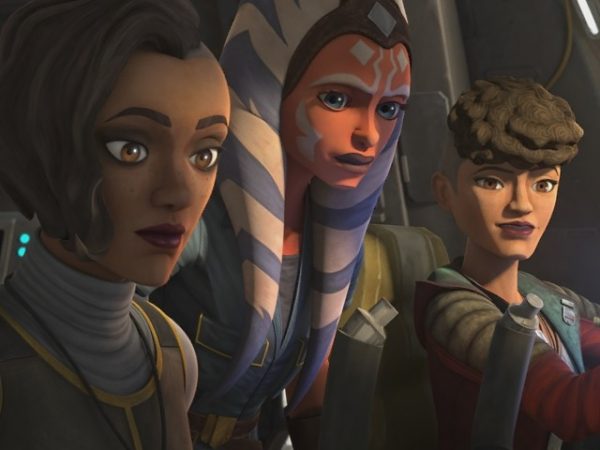Ricky Church looks at the key stories on the road to the Siege of Mandalore…
Back in 2012, just after Disney bought Lucasfilm and began plans on the next trilogy in the Star Wars saga along with spin-offs, television series and comics, an unfortunate casualty of Disney’s purchase was Star Wars: The Clone Wars. The beloved series was cancelled so Disney could produce Star Wars content purely their own since Warner Bros. Television distributed the series, leading the way for Star Wars Rebels but putting several future stories of Clone Wars to a halt.
Series creator George Lucas and showrunner Dave Filoni had a lot planned for The Clone Wars with a sixth, seventh and eighth season in various stages on development due to the long development process with their animation. Some of the completed episodes at the time of the show’s cancellation made their way onto Netflix as a sixth season of ‘Lost Missions’ while others went online in unfinished story reels or were adapted into novels or comic books. There was one story, though, Filoni was keeping very close to his chest for a future opportunity and that was the ‘Siege of Mandalore’.
The ‘Siege of Mandalore’ has been a story teased by several Clone Wars people, including Filoni, Ahsoka actress Ashley Eckstein and Clone Wars‘ Darth Maul Sam Witwer. The arc was said to be the final story in the series’ plot involving the Mandalorians and Maul, but the only teases we’ve ever gotten have been through other material such as the Ahsoka novel from E.K. Johnston and some references in both Rebels and The Mandalorian. With the revived final season of Clone Wars currently airing on Disney+, the first part of ‘Siege of Mandalore’ will air this week so let’s look at all the vital episodes to watch on the road to the Siege.
Death Watch (212 ‘The Mandalore Plot’, 213 ‘Voyage of Temptation’, 214 ‘Duchess of Mandalore’)
Clone Wars begins the story of Mandalore in the second season arc that sees Obi-Wan Kenobi travel to the planet and reconnect with Duchess Satine, Mandalore’s ruler who has transformed their culture from a warrior race to a pacifist society which is remaining neutral in the Clone Wars and has control of 2000 other neutral systems in the galaxy. Obi-Wan and Satine also have a personal history from their teenage years in which they both developed feelings for the other, but being the Jedi he was Obi-Wan stuck to his code and remained with the Order.
Despite the peaceful appearance of Mandalore, however, a group of Mandalorians calling themselves the Death Watch want to overthrow Satine’s rule and bring back their warrior traditions. The arc opens up a new look into Mandalorian society and quietly sets up what is to be one of the biggest overarching stories in The Clone Wars. The political intrigue seen in these episodes is compelling and tense due to Death Watch’s skill. Not only do they have members seemingly embedded throughout Mandalorian society, but they are quite capable of holding off Obi-Wan in a fight, especially their leader Pre Vizsla who wields the rare and ancient Darksaber. Obi-Wan and Satine’s debates over the nature of neutrality in a time of war are not only interesting themes that explore the changes in the Jedi Order, but also sets up some key plot points later in the series.
The Academy (306 ‘The Academy’)
Mandalore doesn’t return in the series again until the third season episode ‘The Academy’ in which Duchess Satine requests the Jedi’s help to root out corruption amid food shortages in their schools and cities. Ahsoka is sent to investigate the corruption and, with the help of Satine’s nephew Korkie, finds the culprit. This episode is a rare one-off for The Clone Wars and sets up some points and characters that play into the coming battle for Mandalore.
Heroes on Both Sides (310 ‘Heroes on Both Sides’)
In the middle of the third season, The Clone Wars jumps ahead in the timeline a bit by aging up Ahsoka and having Anakin and Obi-Wan look more like their appearances in Revenge of the Sith. As Ahsoksa matured, she was introduced to some newer concepts with one of them being the notion that not all Separatists are evil. As she travels with Padmé to a clandestine meeting between her and an old friend of hers who joined the Separatists to begin secret peace talks between their governments, Ahsoka’s worldview is broadened where she starts seeing the Clone Wars in a less black and white perspective. It’s an important moment for her character that feeds into her growth as a Jedi.
Asajj’s Betrayal (312 ‘Nightsisters’, 313 ‘Monster’, 314 ‘Witches of the Mist’)
One of the biggest additions to the franchise The Clone Wars made was making Count Dooku’s apprentice and personal assassin Asajj Ventress canon in the Star Wars mythology, but unlike the Legends stories Dooku is forced to betray Asajj, setting in motion the first of a series of consequences no one could have foreseen (except, perhaps, Palpatine). Asajj survives Dooku’s betrayal and vows revenge, returning to her homeworld of Dathomir. Opening up another new world in Star Wars, Dathomir is occupied by the Nightsisters, a society of fearsome warrior women who utilize a form of magic and witchcraft led by the mysterious Mother Talzin.
The Nightsisters don’t live on Dathomir alone, though. They rule over the Nightbrothers, a group of Zabrak aliens – the same species of the infamous Darth Maul. With Talzin’s help, Asajj finds Savage Opress, Maul’s brother, and with Talzin’s dark magic transforms him into a hulking monster who follows her will. Using him as a tool in her plot against Dooku, Savage trains under the Sith master, but breaks free of the hold both Dooku and Asajj have over him. Unsure of what to do next, Talzin reveals something earth-shattering for Star Wars fans: Darth Maul still lives. With her guidance, he sets off to find Maul and change The Clone Wars – and the future of Star Wars – forever.
A Friend in Need (414 ‘A Friend in Need’)
Following Ahsoka’s exposure to the Separatists in ‘Heroes on Both Sides’, she meets again with her friend Lux Bonteri as he investigates his mother’s murder at the hands of Count Dooku, but his choice of allies prove quite questionable. Rather than relying on Jedi or any other help, Lux has instead turned to Death Watch. Having also been betrayed by Dooku, Vizsla and his band of Mandalorians seek revenge as well and will help Lux achieve his own vendetta.
This is another rare one-off episode for The Clone Wars, but one that can be seen as a continuation of ‘Heroes on Both Sides’ and shows how ruthless Death Watch can be. Though they consider themselves a proud and honourable warrior race, the Mandalorians of Death Watch are ‘honourable’ only to themselves and act more as Vikings as they pillage and enslave a village and have fun doing it. It’s a significant moment to show what Duchess Satine was trying to prevent her world from sliding back into while also introducing Bo-Katan, a high-ranking Death Watch member who seems to be Vizsla’s second-in-command. Though her role in this episode if fairly minimal, she will play a significant role in the future of Mandalore.
Darth Maul Returns (419, ‘Massacre’, 420 ‘Bounty’, 421 ‘Brothers’, 422 ‘Revenge’)

After years of fans’ wishes and several possible stories of his survival, Darth Maul’s return was made official as Savage Opress found his brother and brought him back from the brink of madness after surviving alone and on scraps for the decade-plus after The Phantom Menace. Upon his return, Maul wasted no time in seeking revenge against the Jedi who robbed him of his Sith placement: Obi-Wan Kenobi.
Maul’s return marks a pretty big turning point in the series and he is just as deadly and evil as he was in the first Prequel film with his slaughter of an entire village, beginning with the children. Sam Witwer captures the essence of Maul very well and makes his anger and cruelty quite sinister, doing a more than worthy job on the former Sith apprentice. Though Maul only appears halfway through the arc and doesn’t return to sanity until the finale, the whole arc is entertaining and important not just for Savage and Maul, but for Asajj Ventress as she embarks on a new future. She gets even more ripped from her thanks to Count Dooku and General Grievous and, for the first time in her life, gets to choose for herself in what to do next.
The Shadow Collective (501 ‘Revival’, 514 ‘Eminence’, 515 ‘Shades of Reason’, 516 ‘The Lawless’)
Everything The Clone Wars had set up comes to a head in Season 5’s ‘Shadow Collective’ arc, the second-t0-last of the series’ original run. Viewers would be forgiven in wondering how the plots involving Death Watch and Maul, two seemingly different problems, could ever connect but Filoni and his team merged them magnificently as Maul took a much bigger step in his revenge against not only Obi-Wan, but even his former master Darth Sidious.
After his initial revenge against Obi-Wan failed, Maul decides to branch out and control several criminal syndicates to form one large, galaxy-spanning organization with him at the head. It’s all part of an elaborate plan after a chance meeting with Pre Vizsla and Death Watch, setting off a chain reaction with dire consequences for everyone involved. The action is intense with several lightsaber battles, including one which is arguably Clone Wars‘ grand achievement as Sidious makes his first in-person appearance on the show. Thanks to Maul’s hunger for vengeance, he ignites a Mandalorian civil war and battle within Death Watch that sees Bo-Katan questioning her loyalties and perhaps the choices she’s made that led to these events.
The Departure of Ahsoka (517 ‘Sabatoge’, 518 ‘The Jedi Who Knew Too Much’, 519 ‘To Catch a Jedi’, 520 ‘The Wrong Jedi’)
The original finale to The Clone Wars was a rather bleak one. Ahsoka found herself framed for a terrorist act and went on the run to prove her innocence. Before she was proven innocent the Jedi Council expelled her, essentially throwing her under the bus to save face instead of defending her and launching their own investigation. In the end, it turned out another padawan had become disillusioned with the Jedi Order and was responsible for the crimes and frame job. Ahsoka was welcomed back to the Order, but, to the surprise of Anakin and the other Council masters, Ahsoka decided to leave for good.
This arc is one of the most significant in all of Star Wars media for its bold decisions and examination of how fundamentally flawed the Jedi Council became. The hypocrisy masters like Mace Windu and Ki-Adi Mundi displayed or the inaction taken by Yoda and Obi-Wan just highlighted what had become wrong with the Order during the Clone Wars. The final interaction between Anakin and Ahsoka was heartbreaking and had huge ramifications going forward, not just for Ashoka’s development and The Clone Wars, but for Star Wars Rebels and possibly beyond that as well.
Darth Maul: Son of Dathomir
As already mentioned, when Clone Wars was cancelled stories for future seasons were already in active stages of development. One of those stories would have followed Maul after his defeat at the hands of Sidious in the ‘Shadow Collective’ arc, but rather than let it sit on a shelf due to the cancellation Filoni and Dark Horse Comics (then the stewards of Star Wars comics at the time) turned the unproduced scripts from this arc as the four-issue miniseries Darth Maul: Son of Dathomir. The comic saw Maul continue his quest for revenge against Sidious, Dooku and others who wronged him with his Mandalorian soldiers and criminal cohorts while tying up some loose ends regarding Mother Talzin.
Clone Conspiracy (601 ‘The Unknown’, 602 ‘Conspiracy’, 603 ‘Fugitive’, 604 ‘Orders’)
The first story arc of The Clone Wars‘ ‘Lost Missions’ sixth season – the remaining completed episodes at the time of cancellation – sees ARC Trooper Fives uncover a potential conspiracy regarding the clones that seemingly connects all the way to Chancellor Palpatine. It’s a cool arc that plays around as a conspiracy thriller while adding new context to one of the biggest moments in the Star Wars saga as the war came closer to the Jedi’s extinction with Order 66. Though this arc has nothing really to do with the Siege of Mandalore, if what I think will happen happens it will be very important to watch before the seventh season finale, especially since Captain Rex heard all of Fives’ accusations and he’s still around in Rebels with a scar in particular spot on his head that gives revelations in this story bigger meaning.
The Martez Sisters (705 ‘Gone with a Trace’, 706 ‘Deal No Deal’, 707 ‘Dangerous Debt’, 708 ‘Together Again’)
The most recent arc of The Clone Wars takes place likely a few months after Ahsoka left the Jedi Order as she’s still looking for a new purpose. Continuing her development and broadening perspective, Ahsoka links up with two young sisters in the bowels of Coruscant’s underground as they try to survive and make something of themselves through less than legal means. Trace and Rafa Martez provide Ahsoka with a nice look at what life is like for most of Coruscant’s citizens as well as how they view the big galactic problems, particularly the role the Jedi have taken as the Republic’s law enforcement. It again makes Ahsoka question her previous assumptions while laying the groundwork for the Siege of Mandalore as she comes across some vital information regarding Maul, as well as another meeting with Bo-Katan, by chance.
And that has been the road to ‘The Siege of Mandalore’. Going through this, it’s obvious Filoni and The Clone Wars team had been putting this in place for quite some time as they kept adding elements to build the conflict up as much as possible. With Friday’s upcoming episode the first part of the Siege, it has been a long but hopefully well deserved wait to see it now.
SEE ALSO: Star Wars: The Clone Wars’ final trailer prepares for the Siege of Mandalore
Ricky Church – Follow me on Twitter for more movie news and nerd talk






















